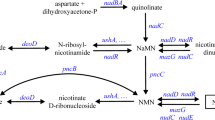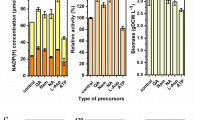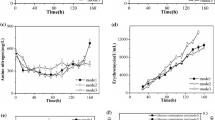Abstract
A range of intracellular NADH availability was achieved by combining external and genetic strategies. The effect of these manipulations on the distribution of metabolites in Escherichia coli was assessed in minimal and complex medium under anoxic conditions. Our in vivo system to increase intracellular NADH availability expressed a heterologous NAD+-dependent formate dehydrogenase (FDH) from Candida boidinii in E. coli. The heterologous FDH pathway converted 1 mol formate into 1 mol NADH and carbon dioxide, in contrast to the native FDH where cofactor involvement was not present. Previously, we found that this NADH regeneration system doubled the maximum yield of NADH from 2 mol to 4 mol NADH/mol glucose consumed. In the current study, we found that yields of greater than 4 mol NADH were achieved when carbon sources more reduced than glucose were combined with our in vivo NADH regeneration system. This paper demonstrates experimentally that different levels of NADH availability can be achieved by combining the strategies of feeding the cells with carbon sources which have different oxidation states and regenerating NADH through the heterologous FDH pathway. The general trend of the data is substantially similar for minimal and complex media. The NADH availability obtained positively correlates with the proportion of reduced by-products in the final culture. The maximum theoretical yield for ethanol is obtained from glucose and sorbitol in strains overexpressing the heterologous FDH pathway.



Similar content being viewed by others
References
Alam KY, Clark DP (1989) Anaerobic fermentation balance of Escherichia coli as observed by in vivo nuclear magnetic resonance spectroscopy. J Bacteriol 171:6213–6217
Berríos-Rivera SJ (2002a) Metabolic engineering of cofactors (NADH/NAD+) in Escherichia coli. PhD thesis, Rice University, Houston
Berríos-Rivera SJ, Bennett GN, San K-Y (2002b) Metabolic engineering of Escherichia coli: increase of NADH availability by overexpressing an NAD+ dependent formate dehydrogenase. Metab Eng 4:217–229
Berríos-Rivera SJ, Bennett GN, San K-Y (2002c) The effect of increasing NADH availability on the redistribution of metabolic fluxes in Escherichia coli chemostat cultures. Metab Eng 4:230–237
Berríos-Rivera SJ, San K-Y, Bennett GN (2002d) The effect of NAPRTase overexpression on the total levels of NAD, the NADH/NAD+ ratio, and the distribution of metabolites in Escherichia coli. Metab Eng 4:238–247
Berríos-Rivera SJ, San K-Y, Bennett GN (2003) The effect of carbon sources and lactate dehydrogenase deletion on 1,2-propanediol production in Escherichia coli. J Ind Microbiol Biotechnol 30:34–40
Boonstra B, French CE, Wainwright I, Bruce NC (1999) The udhA gene of Escherichia coli encodes a soluble pyridine nucleotide transhydrogenase. J Bacteriol 181:1030–1034
Canonaco F, Hess TA, Heri S, Wang T (2001) Metabolic flux response to phosphoglucose isomerase knock-out in Escherichia coli and impact of overexpression of soluble transhydrogenase UdhA. FEMS Microbiol Lett 204:247–252
Clark DP (1989) The fermentation pathways of Escherichia coli. FEMS Microbiol Rev 63:223–234
Kaiser M, Sawers G (1994) Pyruvate formate-lyase is not essential for nitrate respiration by Escherichia coli. FEMS Microbiol Lett 117:163–168
Lundquist R, Olivera BM (1971) Pyridine nucleotide metabolism in Escherichia coli. J Biol Chem 246:1107–1116
Phillips GJ, Park S-K, Huber D (2000) High copy number plasmids compatible with commonly used cloning vectors. BioTechniques 28:400–408
San K-Y, Bennett GN, Berríos-Rivera SJ, Vadali R, Sariyar B, Blackwood K (2002) Metabolic engineering through cofactor manipulation and its effects on metabolic flux redistribution in Escherichia coli. Metab Eng 4:182–192
Snoep JL, Mattos MJTD, Postma PW, Neijssel OM (1990) Involvement of pyruvate dehydrogenase in product formation in pyruvate-limited anaerobic chemostat cultures of Enterococcus faecalis NCTC 775. Arch Microbiol 154:50–55
Tao H, Bausch C, Craig R, Blattner FR, Conway T (1999) Functional genomics: expression analysis of Escherichia coli growing on minimal and rich media. J Bacteriol 181:6425–6440
Tolentino GJ, Meng S-Y, Bennett GN, San K-Y (1992) A pH-regulated promoter for the expression of recombinant proteins in Escherichia coli. Biotechnol Lett 14:157–162
Acknowledgements
This work was supported by the National Science Foundation (BES0000303) and a National Science Foundation Graduate Fellowship (S.J.B.-R., DGE0114264).
Author information
Authors and Affiliations
Corresponding author
Rights and permissions
About this article
Cite this article
Berríos-Rivera, S.J., Sánchez, A.M., Bennett, G.N. et al. Effect of different levels of NADH availability on metabolite distribution in Escherichia coli fermentation in minimal and complex media. Appl Microbiol Biotechnol 65, 426–432 (2004). https://doi.org/10.1007/s00253-004-1609-3
Received:
Revised:
Accepted:
Published:
Issue Date:
DOI: https://doi.org/10.1007/s00253-004-1609-3




